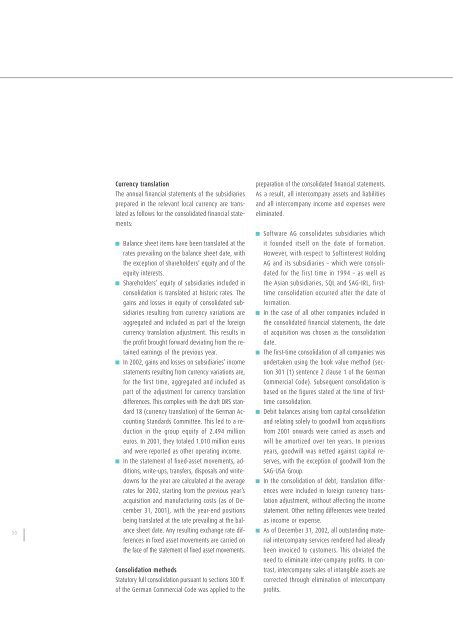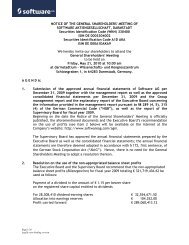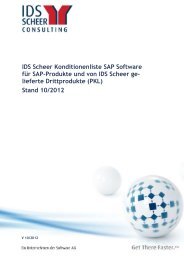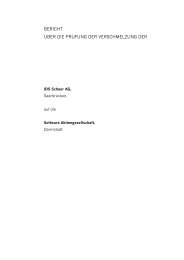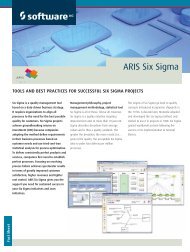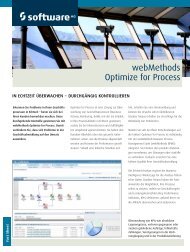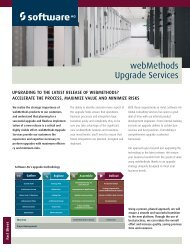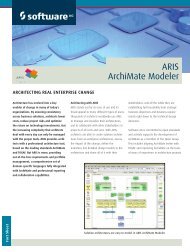Annual Report 2002 - Software AG
Annual Report 2002 - Software AG
Annual Report 2002 - Software AG
You also want an ePaper? Increase the reach of your titles
YUMPU automatically turns print PDFs into web optimized ePapers that Google loves.
50<br />
Currency translation<br />
The annual financial statements of the subsidiaries<br />
prepared in the relevant local currency are translated<br />
as follows for the consolidated financial statements:<br />
Balance sheet items have been translated at the<br />
rates prevailing on the balance sheet date, with<br />
the exception of shareholders’ equity and of the<br />
equity interests.<br />
Shareholders’ equity of subsidiaries included in<br />
consolidation is translated at historic rates. The<br />
gains and losses in equity of consolidated subsidiaries<br />
resulting from currency variations are<br />
aggregated and included as part of the foreign<br />
currency translation adjustment. This results in<br />
the profit brought forward deviating from the retained<br />
earnings of the previous year.<br />
In <strong>2002</strong>, gains and losses on subsidiaries’ income<br />
statements resulting from currency variations are,<br />
for the first time, aggregated and included as<br />
part of the adjustment for currency translation<br />
differences. This complies with the draft DRS standard<br />
18 (currency translation) of the German Accounting<br />
Standards Committee. This led to a reduction<br />
in the group equity of 2.494 million<br />
euros. In 2001, they totaled 1.010 million euros<br />
and were reported as other operating income.<br />
In the statement of fixed-asset movements, additions,<br />
write-ups, transfers, disposals and writedowns<br />
for the year are calculated at the average<br />
rates for <strong>2002</strong>, starting from the previous year’s<br />
acquisition and manufacturing costs (as of December<br />
31, 2001), with the year-end positions<br />
being translated at the rate prevailing at the balance<br />
sheet date. Any resulting exchange rate differences<br />
in fixed asset movements are carried on<br />
the face of the statement of fixed asset movements.<br />
Consolidation methods<br />
Statutory full consolidation pursuant to sections 300 ff.<br />
of the German Commercial Code was applied to the<br />
preparation of the consolidated financial statements.<br />
As a result, all intercompany assets and liabilities<br />
and all intercompany income and expenses were<br />
eliminated.<br />
<strong>Software</strong> <strong>AG</strong> consolidates subsidiaries which<br />
it founded itself on the date of formation.<br />
However, with respect to Softinterest Holding<br />
<strong>AG</strong> and its subsidiaries – which were consolidated<br />
for the first time in 1994 – as well as<br />
the Asian subsidiaries, SQL and S<strong>AG</strong>-IRL, firsttime<br />
consolidation occurred after the date of<br />
formation.<br />
In the case of all other companies included in<br />
the consolidated financial statements, the date<br />
of acquisition was chosen as the consolidation<br />
date.<br />
The first-time consolidation of all companies was<br />
undertaken using the book value method (section<br />
301 (1) sentence 2 clause 1 of the German<br />
Commercial Code). Subsequent consolidation is<br />
based on the figures stated at the time of firsttime<br />
consolidation.<br />
Debit balances arising from capital consolidation<br />
and relating solely to goodwill from acquisitions<br />
from 2001 onwards were carried as assets and<br />
will be amortized over ten years. In previous<br />
years, goodwill was netted against capital reserves,<br />
with the exception of goodwill from the<br />
S<strong>AG</strong>-USA Group.<br />
In the consolidation of debt, translation differences<br />
were included in foreign currency translation<br />
adjustment, without affecting the income<br />
statement. Other netting differences were treated<br />
as income or expense.<br />
As of December 31, <strong>2002</strong>, all outstanding material<br />
intercompany services rendered had already<br />
been invoiced to customers. This obviated the<br />
need to eliminate inter-company profits. In contrast,<br />
intercompany sales of intangible assets are<br />
corrected through elimination of intercompany<br />
profits.


